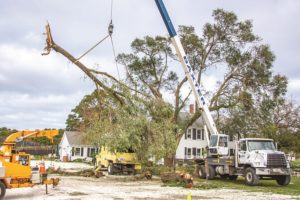PROVINCETOWN — It sounds ironic, but the island of Nantucket is a good place to ride out a nor’easter like the one that struck on Oct. 27, bringing wind gusts clocked at up to 83 miles per hour on the Outer Cape.
Nantucket gets its electricity via two undersea cables. It’s the redundancy in the system that helps keep things running there. Nantucket Town Manager Elizabeth Gibson said she can count on one hand the number of times in the last 26 years that both cables went out at the same time.

Downed trees can still cause localized outages, though another reason the island rarely goes dark for long is that its electricity provider, National Grid, makes tree trimming a priority that far out to sea, Gibson said. On Oct. 27, only five Nantucket homes lost power, according to Mike Dalo, a National Grid spokesman.
On the Outer Cape, meanwhile, thousands of people lost lights, water, and heat when high winds sent tree limbs crashing onto electric lines. Power has since been restored to 480,000 homes statewide, 280,000 of them on the Cape, said Chris McKinnon, a spokesman for Eversource.
In Wellfleet, the wind hit hard, with the strongest gust recorded at 83 m.p.h. at about 2:25 a.m. on Oct. 27, said Torry Gaucher, a meteorologist with the National Weather Service. In Truro, he said, a gust of 80 m.p.h. was recorded at 2:23 a.m. In Provincetown, the wind topped out at 63 m.p.h. at 2:29 a.m. By 5 a.m., the worst was over, Gaucher said. Many people awoke in the gray dawn to no coffee.
This is when you appreciate businesses that have generators. In North Truro, it was Day’s Market & Deli. Mylan Janoplis, the owner, said his store has had a generator for years because Beach Point is so exposed. On Oct. 27, he and his staff of four sold 500 cups of coffee.
“That has never happened before,” Janoplis said. “We could not keep up with it.”
In Wellfleet, it was Blackfish Variety on Route 6. Laura Parker opened by herself. And by the time the second employee, Christina Enos, got in at 8:15 a.m., the parking lot was full. Customers were offering to help make coffee. It went on like that all day.
“At one point, we looked at each other and did not know whether to laugh or cry,” Enos said.
Mary Grace Smith, who lives on Taylor Farm Road in Wellfleet, did not just lose power for four days from the afternoon of Tuesday, Oct. 26 until 7 p.m. on Oct. 29., she was also trapped in her house by a tree that collapsed on one side of her street and downed power lines on the other.
“Fortunately, I have a generator,” she said.
In Truro, the wrapper on the scaffolding surrounding the Highland Light was peeled off by the winds, offering passersby a glimpse of the light’s old familiar form.

Truro Vineyards lost a 200-year-old Siberian elm to the storm, said owner Kristen Roberts. “It wasn’t the mulberry,” Roberts said. “Everybody keeps asking about it, and somehow that tree did survive.”
The elm had already been trussed due to damage from other storms, and the experts from Bartlett Tree Service who helped care for it advised Roberts that it could not safely be saved. Neighbors watched as the complex operation to take it down ensued. “I’m so sad about it,” Roberts said. She said she is making special plans to repurpose the wood.
In Provincetown, most residents got their power back during the day after the worst of the storm had passed, according to Richard Waldo, the DPW director.
Still, restaurants and shops lost food, the library was completely down, and those co-working at the Commons hit the internet via their cell phones while they waited for power to return to the wi-fi system that connects to the Open Cape network.
Provincetown’s CVS staff had to throw out medications and vaccines that required temperature control, said Matt Blanchett, a company spokesman. Pfizer’s Covid-19 vaccine requires storage in an ultra-cold freezer. Moderna’s and Johnson & Johnson’s must be refrigerated, according to the Centers for Disease Control and Prevention.
At the Eastham Superette, owner Sarah Wilcox said they had to toss all their frozen and refrigerated foods after losing power for two full days. It filled two dumpsters, she said.
Is there a way for the Outer Cape to become at least as stormproof as Nantucket?

Eversource’s $46-million battery backup system is under construction at the Provincetown Transfer Station. Town meeting voters authorized the leasing of the land to Eversource in 2019, and the 24.9-megawatt battery was supposed to be up and running by early 2021, according to Eversource’s website. The pandemic delayed construction, Waldo said. It is now expected to be done by the “first half of 2022,” McKinnon said.
The battery should provide power for up to 10 hours during an outage in Provincetown, Truro, and Wellfleet during the winter, and for up to three hours during peak use in the summer, according to Eversource.
“We are really excited about the energy-storing system,” McKinnon said. “It is a first of its kind in this area, and we really think it will make a difference.”
Burying utility cables underground is often suggested as a possibility. Nantucket buried utility lines under about 25 percent of the downtown area during a massive 20-year project that commenced in 1986, Gibson said.
Moving cables underground is expensive — the industry standard ranges from $2 million to $6 million per mile, McKinnon said.
“You cannot just dig a trench — there is a lot of storing of equipment and materials,” McKinnon said, adding, “You have to build up an entire infrastructure.”



